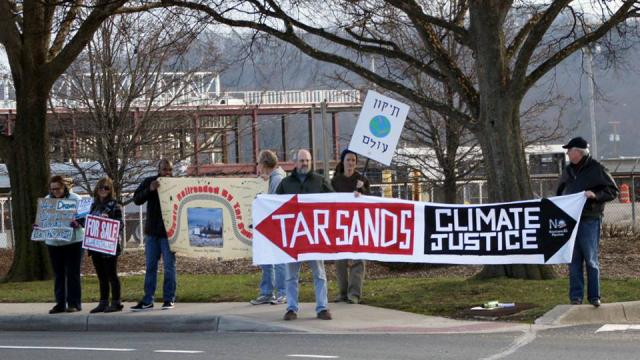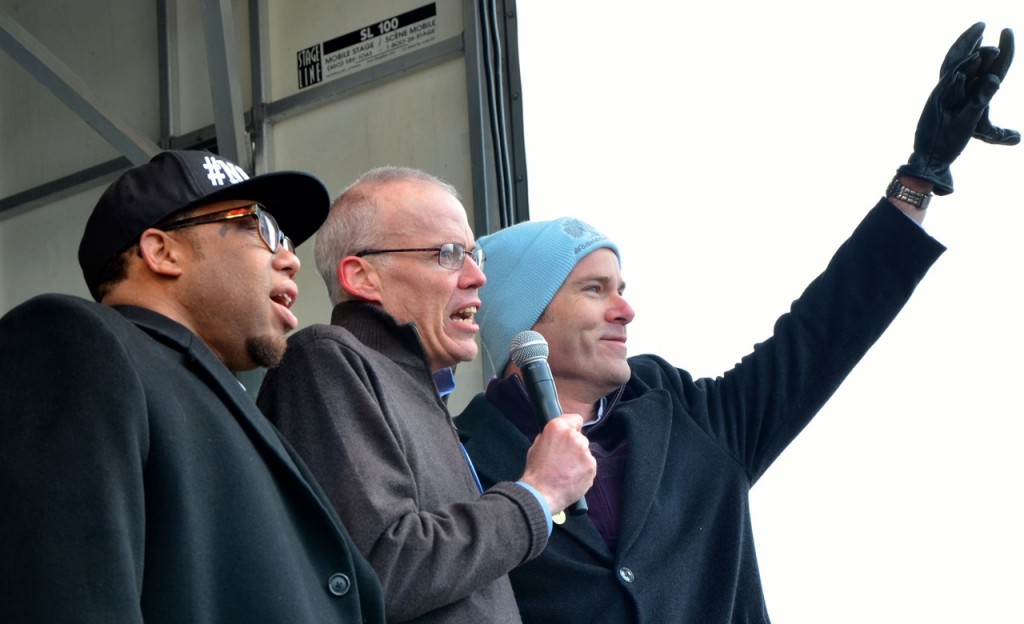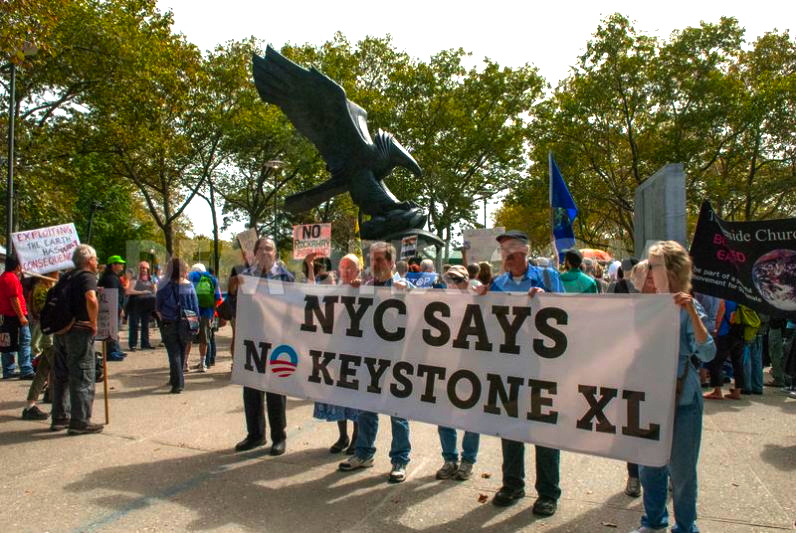
Want a picture that encapsulates the state of Earth and our climate at the moment? Imagine a Dalek – basically an evil R2-D2 on steroids – from the television series Doctor Who howling “Exterminate!” and decked out like a NASCAR with the insignias of leading energy companies along with the emblems of North America's largest financial conglomerates.
Earth has been invaded, occupied by corporations with a robotic lust for profit, whose oil derricks, pipelines and toxic power plants are spawning changes in the atmosphere our climate hasn't witnessed in 65 million years. Yet as fossil-fueled droughts, floods, super-storms and other extreme weather events become the new norm, thousands of people are standing up against Earth's marauders.
“Tar sands development, fracking, mountain top removal for coal, deep water drilling for oil are all part of a new wave, a paradigm shift toward extreme energy,” said filmmaker Josh Fox in Manhattan, who joined one of 200 “Draw the Line” rallies held across the country Saturday.
“All of the people who are on the front-lines are banding together, whether it's in the 34 states that are under the threat of fracking or the first nations communities that are suffering chemical poisoning in their water and their air from tar sands development or the communities that are in the way of the Keystone XL Pipeline.”
The proposed Keystone XL was the focal point of Saturday's demonstrations, continuing a fight picked when 1,200 people were carted away by Capitol police for sitting in at the White House gate in the autumn of 2011. The pipeline would stretch 2,000 miles from Alberta, Canada to the U.S. Gulf Coast and carry approximately 900,000 barrels of the dirtiest fuel on the planet, tar sands oil.
It has has been described by James Hansen of NASA's Goddard Institute for Space Studies, and America's leading climate scientist, as "a fuse to the largest carbon bomb on the planet" that would signal "game over" in humanity's battle with climate change.
Since the pipeline crosses the U.S. border with Canada the approval of the project falls under the State Department's and ultimately President Obama's domain. Pipeline builder TransCanada has already constructed much of the lower half from Oklahoma to Texas and is eager to connect it up with Alberta.
Its potential construction has become a flashpoint for a growing anti-fossil fuel movement targeting the president, TransCanada, the pipeline's financial backers and oil companies like BP, ConocoPhillips and ExxonMobile whose product would reach new markets should the pipeline be built.
Since the sit-ins in Washington, DC, tens of thousands more have rallied against the Keystone XL, including an estimated 40,000 in the nation's capital in February. They have largely been mobilized by the grassroots environmental group 350.org, which orchestrated Saturday's nationwide demonstrations.
In Nebraska, where the Keystone XL is slated to run through the state's Sandhills and Ogallala Aquifer, climate activists together the local farmers union commemorated the raising of a solar and wind powered barn on Saturday. Built directly in the path of where the pipeline would pass should it be approved, the barn not only stands in the way of the Keystone XL but also stands for the clean power people want to foster in their state.
“This land is passed down through five generations,” said Rick Hammond, a Nebraska landowner who donated his property to the project. “Our government is thinking of allowing a big, foreign oil corporation to use eminent domain to threaten the legacy of my children.”
In New York, Josh Fox, echoed Hammond's sentiments. “The fossil fuel industry draws lines all over the place. They draw lines through communities with their pipelines and across the kitchen tables of families whose water they have poisoned. We are all front line communities when it comes to climate change and we are a line they shall not past.”
On Saturday, 400 demonstrators including Fox and myself marched through Manhattan's Financial District Saturday. The crowds surrounded TD Bank, CIBC World Markets and Royal Bank of Canada – three of the Keystone XL's largest financiers – in a blue line that marked where the waters of the Hudson and East River are soon to lap in the coming decades.
New York got a taste of those rising waters last autumn when Superstorm Sandy sent waves crashing through the city's coastal communities. Neighborhoods that were already suffering higher asthma rates due to coal and gas fired power plants suddenly found their homes waterlogged and mold encrusted. Meanwhile, sandbags were stacked high around Wall Street, ensuring that the forces that have used their wealth and influence to keep fossil-fuels burning were shielded from the most severe impacts of the storm they themselves through their investments conjured.
Saturday's demonstrations represented a large, festive and renewed display of the climate movement that has so far kept the Keystone XL at bay despite powerful financial interests pushing for its construction. Some critics of Draw the Line mobilizations argue that even if the Keystone XL is not built, Alberta tar sands oil will still be extracted and exported either by rail or through Canada's Eastern and Western ports.
But anti-pipeline activists backed by 350.org and a coalition of nationwide partners contend that halting the Keystone XL will strike a blow to the industry as a whole, crippling its access to markets while shifting political momentum toward climate justice.
Elsewhere, approximately 100 Draw the Line activists on Saturday picketed tar sands depots along the waterfront in Mobile, Alabama – the largest rail importer of tar sands oil in the U.S. South.
Mobile resident Kim McCuiston said the city's tar sands terminals were approved by the volunteer-run Public Service Commission based on misleading documentation from tar sands traffickers at a time when much of the Mobile community was still focused on cleaning up from the 2010 BP oil spill.
Hearings regarding the terminals were held 168 miles away in Montgomery with only a small ad in the back of the local newspaper alerting Mobile residents that they were taking place. Now, between 20 and 40 rail cars carrying raw bitumen crude arrive in the city each day.
“There is absolutely no hurricane protection,” McCuiston warns of the depots along the Mobile river. “There are no levies. All it would take is a storm surge similar to Hurricane Katrina and we're done for.“
Mobile's historically black neighborhoods, where residents have for decades lived in areas zoned for heavy industry are being hardest hit by the tar sands bonanza. Joe Womack, a resident of the city's Africatown district, noted that Mobile was once a slave trade hub. Where those in bondage were once brought in their decedents are now suffering the consequences of tar sands going out, including high concentrations of hydrocarbons in the air they breathe and polluted water.
“They're picking on us because we're not represented much in politics,” said Womack. “When businesses see water they see dollars, they see industry. We see waterfront communities. We see a fishing peer. We see a welcome center and a historical district that people can visit to learn about our rich past. That's why we're banding together.”
McCuiston says she feels a deep sense of solidarity with families in the pipeline's path and with indigenous peoples living in the vicinity of extraction sites. “This has been devastating to First Nations communities who are having genocide committed against them and I feel like when they ship it down here we're contributing to it. As human beings we shouldn't be doing this at all. I believe we have a moral responsibility to each other and to our planet. I don't want tar sands oil anywhere.”
In a June speech on climate change, President Obama said he would not approve the Keystone XL if it would have an impact on climate change. That's a little like saying, “I won't jump out that hundred story window if it means I'll sprang my ankle.”
Instead, his decision will likely be the result of a political calculation. Whether Obama sides with the Daleks – fossil fuel corporations and their financial backers – or his fellow earthlings could well hinge on whether grassroots efforts against the pipeline can sustain. No matter what happens, the climate movement isn't stopping with the Keystone XL.
And meanwhile, the sun shines upon us and the wind blows against our faces; subtle reminders that another world is possible should we harness its power like we have that of each other.
3 WAYS TO SHOW YOUR SUPPORT
- Log in to post comments

















